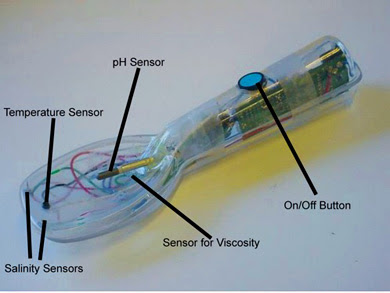Solar Powered LED Light

The LightCap is basically a solar powered water bottle which has a built-in LED light in its lid. It features a waterproof solar panel, battery pack, and "will stay bright for hours while the rechargeable Ni-Cad batteries will last for at least 300 cycles" on a four hour charge -- in sunlight. This device measures 8 ¼" tall and 3 ¾" wide with a 32 oz capacity. No word yet on pricing and availability.
Intelligent Spoon

Connie Cheng and Leonardo Bonanni have developed the world's first "Intelligent Spoon". It's equipped with sensors to measure temperature, acidity, salinity, and viscosity. Download the recorded data to any computer via a cable for furthur processing.
This project aims to introduce computing into traditional culinary utensils. It seeks to provide information, in an integrated manner, about any food the spoon is in contact with, and to offer suggestions to improve the food. The spoon is equipped with sensors that measure temperature, acidity, salinity, and viscosity, and is connected to a computer via a cable. The sensors evaluate the different properties of the food, and send them to the computer for further processing.
" Apart from consolidating measurements that are normally done by an array of equipments into a single spoon,the information obtained can be used to advise the users what their next step should be,for example it tells the user if there is not enough salt in the brine prepared to make pickles "
Citizen's Memory LCD

Citizen Japan has unveiled a new LCD technology -- called "memory liquid crystal" -- that retains the image even when turned off. Basically, its inorganic membrane and angled orientation keep the crystals frozen without needing power. Practical applications would include watches and mobile phone displays.
Used in conventional liquid-crystal orientation polyimide film instead, inorganic orientation film used for the orientation film and liquid crystal molecules with extreme angle of 20 degrees on the memory to achieve. In addition, the gap between conventional glass substrate of about 1 / 3 the following, could improve memory and low-voltage (5 V) is the driving.
Major Features
◆ It is also shown to cut the power is maintained by the memory of a function LCD display.
◆ picture writing except when they are not needed for power, as compared to conventional LCD about 1 / 50 (※ rewriting frequency of 1 / 10 sec for) the low power consumption.
◆ orientation film material is used as inorganic orientation film, film and the orientation of liquid crystal molecules and a 20-degree angle near the pole by setting a sufficient memory to ensure success.
◆ glass substrate of the LCD to the usual gap of about 1 / 3 or less narrowing of the memory of better results occur as expected.
◆ PASSHIBUMATORIKKUSU display system for Adoption, detailed images can be formed.
Uses
◆Electronic shelf tags and other types of meters and as part of the liquid crystal display
◆As mobile phone sub-LCD display Or e-books as part of electronic paper display
◆In addition, low-power consumption is required as part of any liquid crystal display

This Origami DVD Player concept uses a fully-flexib
le display technology (e-paper) to ensure maximum portability. When not in use, the screen folds up neatly back into the case. From the image, it looks to sport integrated speakers as well. No word yet on if this concept will go into production.
"As a product, it would target the business traveler who wants a convenient way to watch DVD movies "
source: http://inventables.com & www.techeblog.com
No comments:
Post a Comment